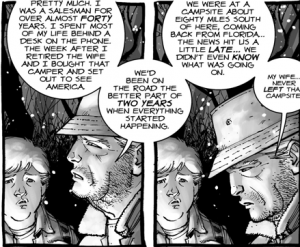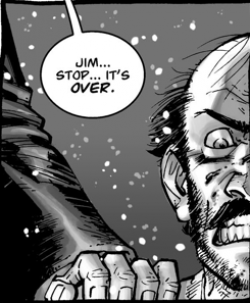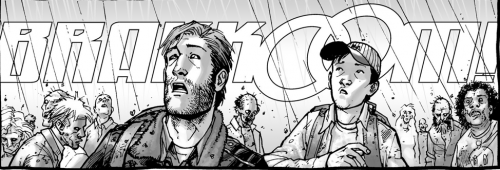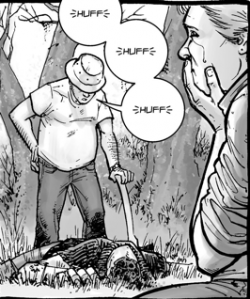This is an old revision of the document!
Text terminology
- Speech Bubble: balloon that comes from mouth of character. What is written here is what the character is saying.
Speech bubbles and their text are rarely described (special instances are provided below); rather, we use a “coded” language to indicate when a special bubble is being used. Listed below are the most common types of speech bubbles, but many more exist. For a more extensive list and visual examples, please visit Blambot.
Common Bubbles
- Scream Bubbles (aka Burst Balloons, Shout Bubbles): These bubbles have a jagged outline, and usually indicate that the character is screaming. When there is a scream balloon, write (for example) ‘’“I ain’t going back! I’ll die first!”, he screams.’’
- Emphasis bubbles (aka Double Outline Bubbles): These bubbles have a bold outline, and may be used to enclose a variety of different speech types. Use a descriptor that best describes how the character is speaking. For example: “No.” She says sharply. Or “Rick!” She yells.
- Whisper Bubbles & Whispered Text: Whispering and muttering may be indicated in a number of ways, including being enclosed in a bubble that uses a dashed outline, or by using text that is smaller than usual. When text is whispered or muttered, simply say so. For example: ‘’”Oh my god…” she whispered.’’
- Thought Bubble: These bubbles have a rounded, cloud like outline, and smaller bubbles for the directional tail. When these are used, say, for example, ‘’”Where am I?” he thinks.’’
As mentioned, speech bubbles are rarely described, but there are occasions when the appearance of the bubble is important to the story, or to the visuals of the comic. Here are a few examples; please note that this list is definitely non-exhaustive. Describe the bubble when:
- It overlaps the gutter.
His answer appears in four speech bubbles which form a chain and cross over the gutter into the next panel.
- It points to an Off-frame character
The tail of a speech bubble leads up and out of frame as the man holding his shoulder says, “Jim…Stop…It’s over.”
- It highlights/appears to highlight an important aspect of story
- e.g. If two people are talking, and one speaker’s bubble covers the other person up in some way, this may be a strong visual representation of “talking over someone”.
- It is different than a standard bubble.
Other Text Effects
- Captions: These do not emanate from any character. The text can appear in a rectangular or square box, or the comic may use its own style, like a banner. Sometimes a caption may appear as floating text. Please see floating caption for more information. They can signify that a narrator is speaking, or the thoughts of a character. Make sure to clarify this in your description, if it is necessary to the narration.
- Write Caption Says…. etc..
- Describe where caption is, and how it looks.
- Caption text floats over bottom right corner of panel.
- Caption text appears in a rectangle at upper left corner of panel.
- Floating caption: This is when a caption is not in any sort of box and appears as floating text over the panel image. This can be described in a similar fashion as mentioned above.
- Write floating caption says…
- Floating Caption text appears in lower right corner of panel.
- Sound effects: These are words that appear outside of speech bubbles and captions and are used to represent a sound. Common examples are the sound of someone falling, or being hit. These words are often in a different and larger font than other text. Write them as they appear in the panel and use the strong style.
- Only describe details of the word if it is part of the visual narration. For example, when the word for the sound overlaps the top of the frame and over the gutter above.
- Sometimes a sound will appear within a speech bubble. In this case describe it as you would dialogue.
- “Oof!” Rick grunts sharply.
- “Sniff, sniff” He smells something in the air.
- Examples of sound effects:
- CLANGG!
- REEARHUH!
- BLAM!
- Breath Marks: Breath marks are little lines that emanate from text within a speech bubble. This will almost always be a “Gasp” or a “Sigh” or a “Huff” - something breathy. They do not need to be described as their use is outlined in the Producer’s Notes. Simply describe it as you would dialogue, like in the “Sniff, sniff” example given below.
“Sniff, sniff.” He smells something in the air.
Additional Resources
For more information on Speech Bubbles and Text please check out these resources:
public/nnels/comics/cbd_textterminology.1533750139.txt.gz · Last modified: 2018/08/08 17:42 by leah.brochu




